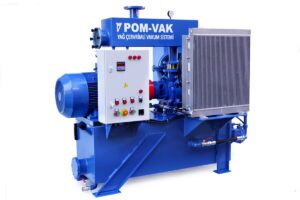Oil Ring Vacuum Systems: Technical Explanation and Applications
Introduction

Oil cycle vacuum pump
Oil ring vacuum systems are highly efficient and durable vacuum pumps specifically designed for industrial vacuum applications. Their oil-based operating principle ensures low friction, high-temperature resistance, and long service life. This article covers the working principle, structural features, advantages, and applications of oil ring vacuum systems.
1. Working Principle of Oil Ring Vacuum Systems
These systems use a rotating oil ring mechanism to create a vacuum. Their working principle includes the following steps:
- A certain amount of oil is filled into the pump chamber.
- As the rotor rotates, centrifugal force pushes the oil towards the inner walls of the pump, forming a ring.
- The varying chamber volumes between rotor blades allow gas intake, compression, and discharge.
- The oil acts as both a sealing and lubricating agent, reducing wear and extending the pump’s lifespan.
2. Structural Features
The key components of oil ring vacuum systems include:
- Rotor and Stator: Facilitate gas movement and compression.
- Oil Chamber: Supports continuous oil circulation for smooth operation.
- Inlet and Outlet Ports: Manage gas intake and exhaust.
- Filtration System: Ensures oil purity and prolongs system life.
3. Advantages
Oil ring vacuum systems offer several key benefits:
- High Performance: Provides consistent and reliable vacuum levels.
- Wear Resistance: Oil protects moving parts, ensuring durability.
- Quiet and Low-Vibration Operation: Minimizes noise pollution.
- High Temperature Tolerance: Suitable for harsh industrial conditions.
- Low Maintenance Requirements: Oil circulation reduces maintenance needs.
4. Applications
Oil ring vacuum systems are widely used in various industries, including:
- Chemical and Petrochemical Industry: Used in chemical processes and solvent recovery systems.
- Food and Beverage Industry: Applied in vacuum packaging and degassing processes.
- Metallurgy and Automotive Industry: Used in vacuum melting, surface coating, and heat treatment.
- Textile and Paper Industry: Essential for vacuum-assisted water removal and drying systems.
- Medical and Pharmaceutical Industry: Utilized in sterilization and pharmaceutical production.
Conclusion
Oil ring vacuum systems play a crucial role in industrial vacuum solutions, offering high efficiency and long service life. Their high-temperature resistance, low maintenance requirements, and quiet operation make them a reliable choice across multiple industries. Selecting the right model can help optimize your processes and improve operational efficiency.



